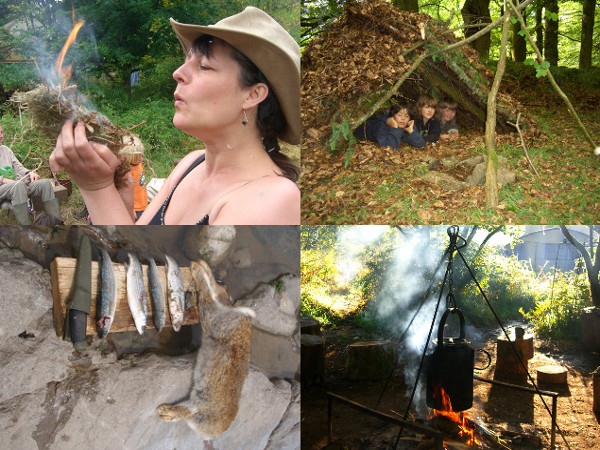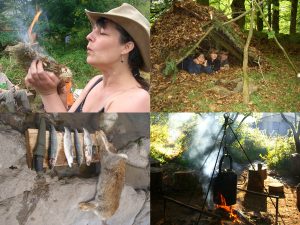“The great thing about bushcraft is that wherever you go, the skills go with you.” – Ray Mears
Contents
What is bushcraft?
Bushcraft is about living in the outdoor environment, in the wild, using knowledge and the natural resources around you to sustain yourself over a prolonged period. But the concept goes beyond mere survival – it’s about thriving, being comfortable in nature. On the other hand, bushcraft has fewer creature comforts and links to civilisation than recreational camping – the more you bring with you, the less you’re doing bushcraft and the more you’re camping. The difference is really about how sustainably you can live outdoors.

Of all our topics, it has the longest history. It’s how our prehistoric ancestors would have lived every day. Sustainability is fundamental to bushcraft, as the close relationship with nature allows you to see clearly if you’re using resources too quickly, or creating waste that can’t be absorbed, or just damaging nature. Unfortunately, the distance between our lives and our environmental impact has made this difficult for most of us today. Ironically, it may be this disconnect that has stimulated such interest in bushcraft.

The essential tasks of bushcraft are obtaining potable water, fire lighting, making shelter and getting and preparing food, which encompasses a range of skills such as flintknapping, firecraft, finding food & water, hunting, fishing, making shelters, rope & cord making, skins & hides, tracking, natural navigation, basketry, leatherwork, and much more.

Quite a large bushcraft movement has developed (more so in the UK and the US than in mainland Europe) from different sources. First there were the survivalists, the most famous of whom was probably Lofty Wiseman, and then the Bush Tucker Man, focusing on food, followed by Ray Mears, whose thoughtful, ecological approach brought bushcraft into millions of living rooms and made it extremely popular. The three main perspectives are probably (still) survivalism; then the Ray Mears / ecological approach; and finally the spiritual / Native American path.
Man and dog build bushcraft shelter without tools.
What are the benefits of bushcraft?
Bushcraft is fun, exciting, (potentially) free, satisfying, and you get to hang out in beautiful places for extended periods. The skills you gain will be helpful in non-bushcraft situations, for example tying knots, foraging, knife work and lighting fires, but they could also save your life or the lives of your loved ones in a survival situation.

It’s also educational, as you’ll gain a much greater understanding and appreciation of nature. And the calming effect of a connection with nature can help people with behavioural or mental health problems.

The environment will of course benefit from a greater number of people who appreciate and respect its beauty and value, and who want to engage with it in a non-exploitative way – it has a lower impact than possibly any other leisure activity, unless of course it involves flying to get to your wilderness. Let’s keep it local folks.
Building a sturdier structure with tools.
What can I do?
Gain some skills by attending a course before you go out into the wild. It’s essential to learn the correct way to do things, especially as regards safety. Of all our topics, it’s probably the one that is least easily learnt from books – although they can certainly increase your knowledge. You can immerse yourself, or focus on specific skills.

Where to do itIf you wish to practice bushcraft on your own there are some access issues to consider. Scotland has different access rights from England & Wales. In Scotland there is much more freedom – you can roam, camp and have a fire without the landowner’s permission, as long as you’re responsible. It’s down to common sense really – think of your impact on the environment and on other people – but it’s useful to read the Countryside Code and the Scottish Outdoor Access Code. In England and Wales legally you should seek permission from a landowner if you wish to practice bushcraft on their land.

‘Leave no trace’ is a good rule of thumb. It means: minimising your impacts, such as avoiding contaminating water sources; minimising fire risk; avoiding erosion; respecting wildlife; not damaging or removing things; burying or burning organic waste and taking everything else away with you (including other people’s rubbish that you find, if possible).

Travelling by canoe or kayak will allow you to be more nomadic, and to carry more kit easily. Hunting wild game is subject to seasons and regulations, and bowhunting is illegal in the UK. You can make your own hooks and natural-fibre lines, or basket/creel-type traps to catch fish or crayfish. Fishing by hand is illegal in the UK, as is spear fishing, except in the sea.

Equipment
Well, it depends on how hard-core you want to be. The less kit used, the ‘purer’ the bushcraft. ‘Bare hands’ bushcraft involves no bought equipment – knives, tools, shelter and fire are made using natural materials. This type of bushcraft is cheaper, obviously, but most people will require at least some basic kit. Here is what you might need:
- Knife and sheath: you can expect to pay £10-15 for a good one. For a reasonable, entry-level knife, Mora make a strong, cheap one. You can have different knives for different jobs, but really, you only need one, and then you don’t have extra tools to carry. A good all-round knife would be medium length, 4-5″ (10-12cm) blade, fairly straight profile towards the tip, full tang (the metal continues from the blade all the way through the handle), with a flat bevel on the blade sloping to a sharp point.
- Water container.
- Fire steel: consists of an alloy and scraper plate; scrape the alloy – it becomes molten and you get sparks.
- Folding saw.
- Water purification aid: millbank bag for filtering; billy can for boiling; or (more expensive) pump filter.
- Bivouac bag, sleeping bag and sleeping mat.
- Shelter: tarp and hammock; most bushcrafters will prefer this, as it’s more ‘outdoors’, lighter weight and allows a fire underneath.
- Outdoor clothing: (depending on the season) thermal layers; outer, waterproof, breathable layer; strong, waterproof boots.
- Rucksack.
Choosing a bushcraft knife.
Search online for bushcraft stores, and for second-hand kit on eBay. It can be a very cheap hobby, but if you’re going to spend money, make sure it’s on a quality knife and fire steel, and apart from those, try to reduce kit rather than increase it.
Health & safety
In the UK we don’t have the kind of large, dangerous or poisonous animals (apart from the adder) that exist elsewhere, which leaves the following main risk areas:
- Fire: take care to avoid wild fires and have water and first aid kit handy in case of burns.
- Shelter: make sure it’s secure and safe – and look overhead to see what might potentially fall on you.
- Coastal areas: avoid camping or sheltering below the high-tide line, and beware of falling rocks from cliffs.
- Wild food: to avoid poisoning yourself, make sure you can identify plants; be aware of the risk of allergies and contamination (wash/cook food properly).
- Water: collect water close to its source to avoid chemical contamination. Usually you will assume the water has some form of biological contamination – but it can be treated effectively by filtering and boiling. Chemicals are more difficult to treat unless you have a carbon filter, therefore it is best to avoid places where chemical contamination is suspected.
- Tool use: avoid cutting yourself, by making the tool safe when not in use – sheath a knife when walking around; always cut away from yourself; definitely don’t work with cutting tools between your legs, because it would be very bad news to cut the femoral artery in your legs. Be aware of other people – give them plenty of space when using a sharp tool, and make them aware of what you’re doing.

Of course you wouldn’t want to hurt yourself in any of the above ways at all – but definitely not in the wilderness, a long, long way from the nearest hospital.
Specialist(s)
Thanks to Leon Durbin of Wildwood Bushcraft for information | pics © Wildwood Bushcraft and Wildwise
The specialist(s) below will respond to queries on this topic. Please comment in the box at the bottom of the page.
 Leon Durbin has had a lifelong passion for wildlife and wild places, and is a qualified and experienced wildlife biologist. Leon runs Wildwood Bushcraft, and has been teaching and practicing bushcraft for the last 15 years.
Leon Durbin has had a lifelong passion for wildlife and wild places, and is a qualified and experienced wildlife biologist. Leon runs Wildwood Bushcraft, and has been teaching and practicing bushcraft for the last 15 years.



2 Comments
We have lost the natural ability that our ancestor use them to thrive on wild. Thanks for sharing.
Hi I would like to say that humans (sapiens) have never been fully in touch with nature (except sorta when we were on the Afro-Asian landmass) but bushcraft is much more sustainable to where we are now.